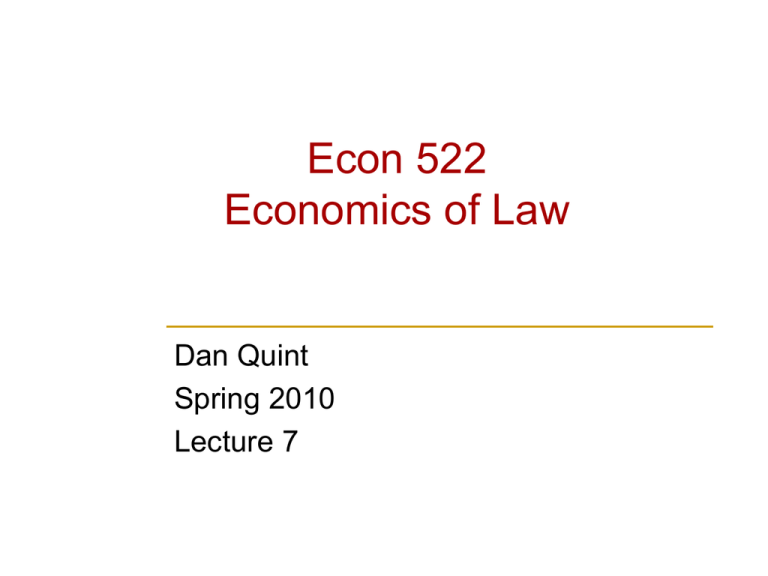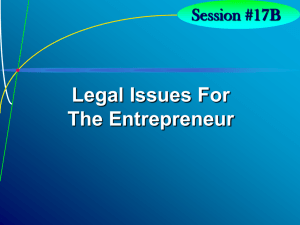Econ 522 Economics of Law Dan Quint Spring 2010
advertisement

Econ 522 Economics of Law Dan Quint Spring 2010 Lecture 7 back to Intellectual Property 1 Intellectual Property Intellectual property: broad term for ways that an individual, or a firm, can claim ownership of information Patents – cover products, commercial processes Copyrights – written ideas (books, music, computer programs) Trademarks – brand names, logos Trade Secrets 2 up-front investment: 1,000 monopoly profits: 2,500 duopoly profits: 250 each Example of a patent: creating a new drug FIRM 1 (innovator) FIRM 2 (imitator) Innovate Don’t Without patents: Drug never discovered (0, 0) Imitate (-750, 250) Don’t (1500, 0) FIRM 1 (innovator) With patents: Drug gets discovered But… FIRM 2 (imitator) Innovate Don’t (0, 0) Imitate (-750, 250 – P) Don’t (1500, 0) 3 Since monopoly is inefficient, important tradeoffs in patent design Patent breadth Patent length tradeoff: how long to maintain ex-post inefficiency (monopoly) to create enough incentive for innovation? 4 Since monopoly is inefficient, important tradeoffs in patent design Patent breadth Patent length tradeoff: how long to maintain ex-post inefficiency (monopoly) to create enough incentive for innovation? Alternatives to patents government purchase of drug patents prizes direct government funding of research 5 patents copyrights trademarks trade secrets 6 Copyright Property rights over original expressions writing, music, other artistic creations These tend to fit definition of public goods nonrivalrous nonexcludable so private supply would lead to undersupply Several possible solutions government subsidies charitable donations legal rights to creations – copyrights 7 Copyright Copyright law less rigid than patent law Unlike patent law, allows for certain exceptions Copyrights last much longer than patents Current U.S. law: copyright expires 70 years after creator’s death No application process Copyright law automatically applies to anything you’ve written/created 8 Copyright Copyright law less rigid than patent law Unlike patent law, allows for certain exceptions Copyrights last much longer than patents Current U.S. law: copyright expires 70 years after creator’s death No application process Copyright law automatically applies to anything you’ve written/created Copyrights more narrow than patents Cover exact text, not general idea 9 Copyright Copyright law less rigid than patent law Unlike patent law, allows for certain exceptions Copyrights last much longer than patents Current U.S. law: copyright expires 70 years after creator’s death No application process Copyright law automatically applies to anything you’ve written/created Copyrights more narrow than patents Cover exact text, not general idea 10 patents copyrights trademarks trade secrets 11 Trademarks Trademarks do not expire, as long as they’re not “abandoned” No trade-off between long-term incentives (innovation) and shortterm inefficiency (monopoly) – little apparent downside 12 Trademarks Trademarks do not expire, as long as they’re not “abandoned” No trade-off between long-term incentives (innovation) and shortterm inefficiency (monopoly) – little apparent downside 13 Trademarks Trademarks do not expire, as long as they’re not “abandoned” No trade-off between long-term incentives (innovation) and shortterm inefficiency (monopoly) – little apparent downside Protected against infringement and also dilution 14 patents copyrights trademarks trade secrets 15 Trade Secrets Protection against misappropriation But plaintiff must show… Valid trade secret Acquired illegally Reasonable steps taken to protect it 16 patents copyrights trademarks trade secrets 17 More on: what can be privately owned? 18 Organizations Most organizations are not owned by anyone churches, clubs, cooperatives, charities, etc. But many corporations are owned can be bought and sold like property General principle: Organizations whose primary purpose is to earn profits should be owned Organizations whose primary purpose is something else should not Ownership leads to a principal-agent problem 19 Multiple forms of public ownership Open Access Anyone free to use the resource Leads to overutilization (Tragedy of the Commons) Example: oyster beds Unanimous Consent Opposite of open access – multiple owners must all agree to any use of the resource Leads to underutilization Example: empty storefronts in post-Communist Moscow Political Control/Regulation 20 Third form of public ownership: political control/regulation Dividing the mountain pasture among individual owners would require fencing it, which is prohibitively expensive. Instead, the highland pasture is held in common, with each village owning different pastures that are separated by natural features such as lakes and mountain peaks. If each person in the village could place as many sheep as he or she wanted in the common pasture, the meadows might be destroyed and eroded by overuse. 21 Third form of public ownership: political control/regulation In fact, the common pastures in the mountains of Iceland have not been overused and destroyed, because the villages have effective systems of governance. They have adopted rules to protect and preserve the common pasture. The sheep are grazed in common pasture in the mountains during the summer and then returned to individual farms in the valleys during the winter. The total number of sheep allowed in the mountain pasture during the summer is adjusted to its carrying capacity. Each member of the village receives a share of the total in proportion to the amount of farmland where he or she raises hay to feed the sheep in the winter. 22 How are property rights established/verified? 23 Fugitive property Hammonds v. Central Kentucky Natural Gas Co. Central Kentucky leased tracts of land above natural gas deposits But geological dome lay partly under Hammonds’ land Hammonds sued, claiming some of the gas they were extracting was his (Anybody see “There Will Be Blood”?) 24 Two principles for establishing ownership First Possession fugitive property belongs to nobody until someone extracts it, establishing ownership Central Kentucky would own all the gas, since they were first to actually possess it Tied Ownership ownership of fugitive property is tied to something else which is easier to establish – in this case, surface of the land Hammonds would own some of the gas, since it was located under his land principle of accession – a new thing is owned by the owner of the proximate or prominent property 25 First Possession versus Tied Ownership First Possession generally simpler to apply – easy to determine who possessed property first but, incentive to invest too much to early in order to establish ownership 26 First Possession versus Tied Ownership First Possession generally simpler to apply – easy to determine who possessed property first but, incentive to invest too much to early in order to establish ownership Tied Ownership encourages efficient use of the resource (no need to extract quickly) but, difficulty of establishing and verifying ownership rights 27 This brings us to the following tradeoff: Rules that link ownership to possession have the advantage of being easy to administer, and the disadvantage of providing incentives for uneconomic investment in possessory acts. Rules that allow ownership without possession have the advantage of avoiding preemptive investment and the disadvantage of being costly to administer. 28 A nice historical example: the Homestead Act of 1862 Meant to encourage settlement of the Western U.S. Citizens could acquire 160 acres of land for free, provided head of a family or 21 years old “for the purpose of actual cultivation, and not… for the use or benefit of someone else” had to live on the claim for 6 months and make “suitable” improvements Basically a first possession rule for land – by living on the land, you gained ownership of it Friedman: caused people to spend inefficiently much to gain ownership of the land 29 Friedman on the Homestead Act of 1862 “The year is 1862; the piece of land we are considering is… too far from railroads, feed stores, and other people to be cultivated at a profit. …The efficient rule would be to start farming the land the first year that doing so becomes profitable, say 1890. But if you set out to homestead the land in 1890, you will get an unpleasant surprise: someone else is already there. …If you want to get the land you will have to come early. By farming it at a loss for a few years you can acquire the right to farm it thereafter at a profit. How early will you have to come? Assume the value of the land in 1890 is going to be $20,000, representing the present value of the profit that can be made by farming it from then on. Further assume that the loss from farming it earlier than that is $1,000 a year. If you try to homestead it in 1880, you again find the land already taken. Someone who homesteads in 1880 pays $10,000 in losses for $20,000 in real estate – not as good as getting it for free, but still an attractive deal. …The land will be claimed about 1870, just early enough so that the losses in the early years balance the later gains. It follows that the effect of the Homestead Act was to wipe out, in costs of premature farming, a large part of the land value of the United States.” 30 When should resources become privately owned? First Possession and Tied Ownership are doctrines for how ownership rights are determined Next question: when should a resource become privately owned? Cost of private ownership: owners must take steps to make the resource excludable – boundary maintenance Cost of public ownership: congestion and overuse An economically rational society will privatize a resource at the point in time where boundary maintenance costs less than the waste from overuse of the resource. 31 When should resources become privately owned? First Possession and Tied Ownership are doctrines for how ownership rights are determined Next question: when should a resource become privately owned? Cost of private ownership: owners must take steps to make the resource excludable – boundary maintenance Cost of public ownership: congestion and overuse An economically rational society will privatize a resource at the point in time where boundary maintenance costs less than the waste from overuse of the resource. (either because congestion got worse… or because boundary maintenance became cheaper) 32 What can be done to prove ownership of something? Branding cattle Vehicle ID numbers on cars States grant deeds for property, and keep registry of legal owner 33 What can be done to prove ownership of something? Branding cattle Vehicle ID numbers on cars States grant deeds for property, and keep registry of legal owner No such system for apples Too many apples – high cost of maintaining a registry Apples inexpensive – not much of a problem 34 That’s all for today Next week: limitations/exceptions to property law more on remedies governmental takings (eminent domain) and an interesting (hopefully) experiment If you want to read ahead: Blume and Rubinfeld article Have a good weekend! 35

